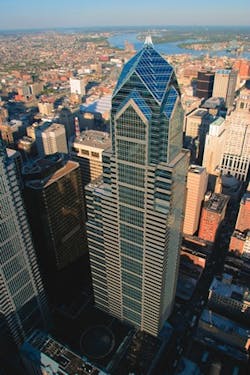Newsworthy
Bring Your Green to Work
In September, the U.S. Environmental Protection Agency (EPA) launched a new online tool called ENERGY STAR @ work. An animated office cube, the tool provides specific tips on how to save energy at the office. (Take a tour of the tool at www.energystar.gov/work.) Energy use in commercial buildings and manufacturing plants accounts for nearly half of total U.S. greenhouse-gas emissions and nearly 50 percent of energy consumption nationwide, so why not encourage employees and building tenants to bring green practices to the buildings in which they spend most of their time?
Maura Cantor Beard, director, strategic communications, ENERGY STAR Commercial and Industrial Buildings, U.S. EPA, tells Buildings readers why they should utilize this tool in their facilities, and how to form green teams to reinforce the green message.
Buildings: Why should our readers use this tool and encourage their employees/tenants to as well?
Cantor Beard: Everyone can make a difference when it comes to saving energy in the places where we work, shop, play, and learn. Often, facility managers and buildings owners are actively involved in the energy-management efforts of a building, but employees and tenants may not be aware of what they can do to help save energy and complement the efforts of the building manager or owner. Simple steps in an employee workspace - such as changing a desk lamp or unplugging a cell-phone charger - can make a big difference in the overall energy performance of a building. ENERGY STAR @ work provides tips like these, and links to valuable information that employees can use on a daily basis.
Buildings: What long-term benefits can be gained from using this tool?
Cantor Beard: To improve and sustain energy efficiency over the long term, a strategy that involves everyone in an organization - from corporate executives to building managers to employees - offers the greatest likelihood of success. The ENERGY STAR @ work tool is a valuable resource in such a strategy, and it can raise awareness whether you're in human resources or the research department, or whether you're a top executive or a summer intern.
Buildings: What advice do you have for starting a green team?
Cantor Beard: One person can't do it all. So, when it comes to making your workplace greener and more energy efficient, nothing beats a team. Forming a green team is a great way to help reduce office waste and increase energy efficiency.
To hit the ground running, consider these tips:
- Organize your green team. Get management approval and encourage coworkers from different levels and parts of your organization to join in.
- Start your green program. Identify project areas and opportunities, develop work plans, and host an official launch or kickoff event.
- Raise awareness. Share tips and advice on how to save energy and reduce waste. Tip cards and posters in breakrooms are great ways to raise awareness.
- Recognize success. Celebrating achievements will help sustain motivation.
Living Building Coming to Pittsburgh
Slated to be one of the world's greenest buildings, ground was broken in September for the Phipps Conservatory and Botanical Gardens' Center for Sustainable Landscapes in the Oakland area of Pittsburgh. Qualifying as a "living building," the center will be a zero-net-energy structure that generates all of its own energy with renewable resources, and captures and treats all of its water onsite. Phipps expects the center to exceed a LEED Platinum rating by employing leading-edge and exploratory technology to set new standards for green buildings, while using an integrative design approach to ensure a smooth construction process. When completed, the facility will house administration, education, and research functions.
DOE Finds EIFSs to be Energy Efficient
Exterior insulation and finish systems (EIFSs) performed better than brick, stucco, and fiber cement siding in a U.S. Department of Energy (DOE) study that measured energy efficiency, moisture intrusion, and temperature control.
The study concluded that an EIFS is a preferable exterior cladding choice for its high marks in energy efficiency (by controlling heat flow more efficiently), among other performance goals. The best-performing wall configuration with respect to positive heat flux during the cooling months (keeping heat out) was an EIFS with toweled-applied water-resistive barrier coating applied behind the EIFS.
Luxury Philadelphia Condos Top Highest Prices in History
The Residences at Two Liberty Place in Philadelphia has made history with the highest prices per square foot ever recorded in residential real estate: $1,370 per square foot.
A signature landmark of the Philadelphia skyline, the iconic tower was designed by Helmut Jahn of Chicago-based Murphy/Jahn Architects and redeveloped by the Boca Raton, FL-based Falcone Group. Inside the skyscraper are 90 super-luxury condominiums that begin on the 40th floor and continue to the penthouse on the 57th floor. Ranging from 1,150-square-foot, one-bedroom-plus dens to a 12,000-square-foot, full-floor mansion, the condos feature expansive layouts and wall-to-wall windows. Two Liberty Place residences also include a touch-screen Virtual Concierge to complement the personal concierge staff, which allows owners to order room service, call the valet for their cars, or reserve a spa treatment - just by touching a screen. Full occupancy is expected in 2009.
The EnergySmart Hospitals initiative was announced by the U.S. Department of Energy (DOE) to increase the use of energy-efficient technologies in nearly 8,000 hospitals across the country. Because hospitals are among the most energy-intensive commercial buildings, the initiative will target 20-percent improved efficiency in existing hospitals and 30-percent improvement over current standards in new construction. The initiative has the potential to help healthcare facilities reduce greenhouse-gas emissions and save millions of dollars in energy costs.
San Francisco Approves Green-Building Standard
San Francisco Mayor Gavin Newsom recently approved a green-building ordinance that imposes strict requirements on newly constructed residential and commercial buildings within the city, as well as on building renovations.
For commercial buildings and high-rise residential buildings, the ordinance adds requirements from the U.S. Green Building Council's LEED rating system. Starting this month (if the California Energy Commission approves the legislation), new permit applications for high-rise residential buildings must include documentation to achieve LEED certification (or 50 GreenPoints, a rating system developed by Berkeley, CA-based Build It Green). Starting in 2010, they must include documentation to achieve LEED Silver certification (or 75 GreenPoints). A number of specific LEED standards must also be met for landscaping, water-use reduction, and construction-debris management.
Mid-sized commercial buildings don't need to meet LEED-certification requirements, but must meet LEED standards for building commissioning, landscaping, water use, and construction-debris management starting in 2009. In 2012, the buildings must also meet LEED standards for the use of onsite renewable energy or the purchase of renewable energy credits.
The toughest requirements apply to large commercial buildings. For new large commercial interiors and major alterations to existing buildings, new permit applications must include documentation to achieve the same LEED rating requirements as for new large commercial buildings, and must also meet LEED standards for materials that emit low levels of indoor pollutants.
Survey Says: Competitive Advantage with Project-Management Software
Respondents to a recent survey confirmed that the use of project-management software not only enhances project control, improves visibility, and standardizes processes, but it also provides a competitive advantage and delivers a return on investment that increases over time.
The survey, conducted by Raleigh, NC-based FMI Corp., says that annual savings with project-management software were more than $1 million for some organizations, with an average annual ROI of more than $200,000. Survey respondents also said that:
- They consider flexibility and ease of use to be the most important features in a project-management system.
- They experienced overall improvement in project control due to better communication.
- Contract/change management and document management were the most widely used functions in their systems.
Survey Says: 42 Percent of Small Businesses Lack Disaster Plans
A recent national survey shows that an alarming number of small businesses remain unprepared to face a disaster (hurricane, tornado, wildfire, computer virus, etc.), and the majority of these businesses have no plans to change. Commissioned by Delray Beach, FL-based Office Depot, the survey of small businesses shows that 40 percent admit to not being ready for a disaster; one-third (27 percent) indicate that they don't have any plans of becoming prepared.
Of the businesses indicating that they were not prepared for a natural disaster:
- 37 percent had not taken the time to prepare.
- 17 percent indicated it was too expensive.
- 11 percent don't know what to do.
"What's most alarming about these new survey findings is that small businesses still have strong misperceptions about what they can do to help prepare for a disaster so that they'll be ready to handle any potential business interruption," says Tom Serio, director of global business continuity for Office Depot.
In explaining why they've taken steps to prepare their businesses this year, nearly two-thirds (61 percent) of the 5,000 small business professionals who responded indicated that they realized it doesn't have to cost a lot of money or time to get prepared.
To help educate and motivate small business owners to protect their businesses from a disaster, Office Depot joined with technology and data storage expert Jon Toigo to compile a downloadable Expecting the Unexpected: Disaster Preparedness Strategies for Small Business brochure. The brochure is available at www.officedepot.com/getprepared.
"Small businesses need to understand that not having a plan or back-up system in place can result in a business closing for good," says Toigo. "A sound contingency plan can help your small business respond effectively to a crisis and prevent that crisis from becoming a full-fledged disaster."
The Office Depot survey did show that small business owners living in natural-disaster-prone regions are more inclined to prepare for disasters. But, nationally speaking, a full 25 percent of business owners describe their attitudes toward disaster preparation as "live and let live," explaining that they would rather deal with a disaster when it occurs instead of getting ahead of a potential problem.
While the cost of planning measures will vary, it's clear: Businesses that are prepared are much more likely to recover than those that are not. According to the survey data, of those businesses that experience a disaster and have no emergency plan, 43 percent never reopen.
Lighting Research Center Assesses Light Pollution
Scientists at the Lighting Research Center (LRC) at Troy, NY-based Rensselaer Polytechnic Institute have developed the first-ever comprehensive method for predicting and measuring various aspects of light pollution. Too much nighttime illumination can cause problems for stargazing and animal health, and may even compromise sleep, but light pollution may not be an issue that most facility managers and building owners consider a top priority. Balancing public and private interests for nighttime lighting has been a difficult undertaking - too little lighting may increase safety and security issues, and too much lighting may cause problems for the environment and human well being - but the LRC research hopes to simplify the problem.
The LRC method, called Outdoor Site-Lighting Performance (OSP), allows users to quantify and optimize the performance of existing and planned lighting designs and applications to minimize the amount of excessive or obtrusive light that leaves the boundaries of a property.
"Until now, the conversation about light pollution had been just that - a lot of talk with no data," says Mark Rea, LRC director and principal investigator for the project. He also says the new method "is a power tool, allowing users to address three important aspects of light pollution - sky glow, light trespass, and discomfort glare - quantitatively and at the same time."
Developed as a practical system for assessing outdoor lighting performance, the OSP method can be used with any commercial lighting software. A database of results has been created to help users compare the performance of their own projects to the glow, trespass, and glare levels measured at nighttime lighting applications across North America and Europe.
Flexible Interiors at New Palm Beach Community College Building
The new Natural Science Building has opened at Palm Beach Community College (PBCC) in Lake Worth, FL. The 50,000-square-foot, 2-story building includes educational spaces that can change each hour to support various teaching methods and learning styles. This flexibility also extends to office workspaces, which were designed to enable wellness and productivity for employees.
"We believe very strongly in student engagement, and the Natural Science Building reflects that philosophy," says Dr. Magdala Ray, PBCC dean of baccalaureate studies. "The interiors make it easy for instructors to customize a classroom's layout to accommodate visual, auditory, kinesthetic, and other types of learners while, at the same time, providing a high degree of comfort for students."




